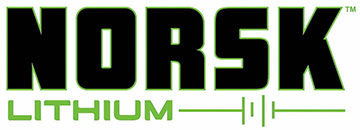| Why Lithium Batteries Should Be In Your Boat |
| Longevity, reliability, reduced weight, and real-time monitoring are just a few features that make today’s lithium marine batteries the best choice |
| New Hope, Minn. (May 19, 2023) – Many early adopters of lithium marine batteries have strong opinions. It’s true—a lot of the first products to hit the market were prone to failure, offered questionable performance, and were very expensive compared to lead acid, AGM, and gel cell alternatives. Despite these growing pains, it seems the entire world has gone the way of lithium battery power. It’s all around us, from inside the computers and phones we rely on every day to medical devices implanted in the human body. Power tools, lawnmowers, snowblowers, generators, and anything you might have in the garage that once took fuel or AC/DC can now be efficiently and safely powered by lithium batteries. With chemistries changing for the better over the past couple years, lithium batteries are not only being used in our homes, they are the backbone to many mission-critical industries—from medical devices to aerospace. And it looks like the marine electronics/boating markets are next…If lithium batteries are so great, then why aren’t more anglers and boaters using them?Many anglers—even guides and pros—have only a limited understanding of how lithium battery technology works and its many benefits. First, potential customers shy away from the price tag, having no idea that it’s actually more cost-effective to operate lithium in the long-run. Amortized over 10 to 12 years, the cost of running lithium is actually less than having to replace a boat’s lead acid battery banks every two to three years. Another issue? A lot of anglers are still living in the past, and rigging their boats each season like they did ten years ago. Problem is, power consumption on your typical fishing boat has drastically increased as fish-finder screens have grown larger, brighter, and like technological leaps in personal computing, now operate with faster but power-consuming processors. Same goes for the progression we’ve experienced with trolling motors, electronic shallow-water anchors, forward-facing sonar, and other imaging technologies and their requisite power requirements. Not only do these technologies require a lot of power—they need a clean source of power with steady voltage for optimum screen resolution, brightness, and on-screen fish/structure imaging. Compare the imaging on a graph being powered with lithium versus lead acid; the difference in picture quality is very noticeable. Yes, running today’s fishing electronics requires a lot of juice—and you better have it or you’re destined for compromised performance, short days on the water, and sad songs back at the dock. |
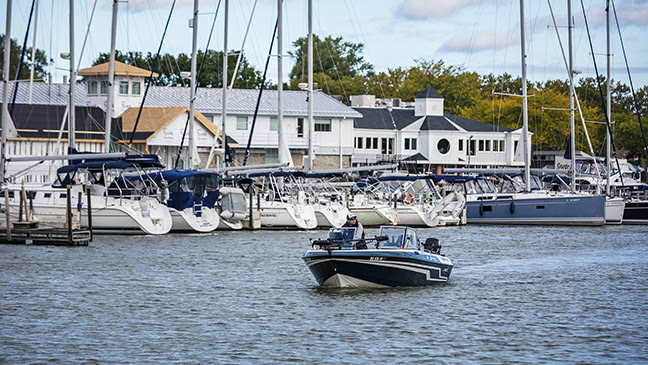
| Battery Types ExplainedFirst, let’s walk through the three major types of marine batteries so we can compare the benefits of lithium to what’s traditionally been used for onboard, marine power.12-volt marine batteries fall into three main categories: Starting (aka “cranking”) batteries, deep-cycle batteries, and dual-purpose batteries.Hence the name, starting batteries are designed to start the main boat outboard; deep-cycle batteries are intended to power accessories, electronics, and trolling motors; and lastly, dual-purpose batteries will power both outboard engines and accessories/fishing electronics. Marine starting batteries allow quick bursts of power via cold-cranking amps (CCA) to turn over an outboard; then, when the engine is running, they provide power for accessories, with battery power constantly replenished by the outboard’s alternator.A starting battery does not work well in a deep cycle application because of the internal arrangement of the plates and its inherent design.Deep-cycle batteries—as opposed to starting or “cranking” batteries—are designed to provide lower amp draws over a longer period of time to marine accessories like fishing electronics, trolling motors, livewell and bilge pumps, radios, etc.*Note: Your outboard does not need to be running for deep-cycle batteries to do their job. They are not replenished in any way by an outboard’s alternator.In terms of construction, a deep cycle battery has fewer bulky and thick lead plates than a lead acid starting battery. A starting battery has thinner plates but more of them. Operation-wise, starting batteries require ample surface area through which to release more current in a short amount of time—what is required when starting an outboard.A dual-purpose battery has a mixture of both starter and deep cycle battery plates, and, as is true with most products intended to serve double-duty, the dual purpose battery makes a serviceable starting or deep cycle battery in a pinch but isn’t perfectly designed for either application. The attraction to some anglers to the dual-purpose battery is thinking that, if they need to start their outboard in a pinch, they could start their big motor with a dual-purpose battery that is primarily used to power accessories. |
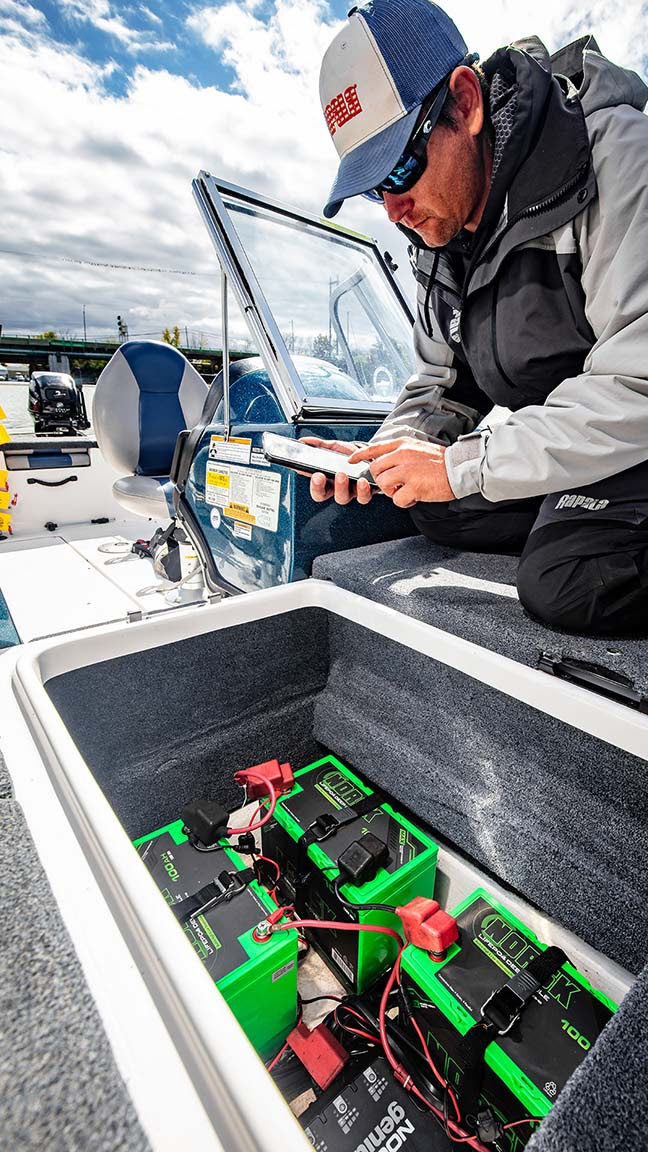
| Lead Acid BatteriesLead acid batteries are the marine standard and have been used by anglers for countless decades. Design-wise, lead acid batteries are composed of big, heavy lead plates that are surrounded by acid which is the medium through which the charge travels from one plate to the next. Prior to AGM, gel cell, and lithium, lead acid was the only game in town. The drawbacks? Limited longevity/charge-discharge cycles, weight, and outdated technology for producing DC current. But the major drawback with your average lead acid battery is you can’t use it to its full capacity, something most anglers and boaters are completely unaware of. While big, heavy lead acid batteries may give a boater or angler the impression they have a significant power supply, the reality is you can only utilize about 50% of the capacity before you start damaging a lead acid battery. Frequently discharge your lead acid battery beyond 50% of the capacity and the damage occurs rapidly–and the damage is permanent.The result? Before long, if you’re fishing long and hard, you’ve got a battery that needs replacement. The average life of a lead acid battery for an angler who fishes long days is just under two years. Toward the end of its life, a lead acid battery is apt to only provide 5 or 6 hours of on-the-water runtime, which is unacceptable to most serious anglers. Lead acid batteries’ power curve – how they discharge current – exhibits a huge voltage drop when you apply a load. The voltage will go from 13 volts into the low 12s, even with small loads, in a very short amount of time. Thus, the battery you started with at the beginning of the day is not the battery you end up utilizing in your boat by lunchtime. Depending on how you use the lead acid battery—like if you’re powering lights—you’ll notice that the lights dim and aren’t as bright over time. You also see that a lot with trolling motors. As that voltage curve drops, the trolling motor power head and prop will start to slow down so the user experience—even fairly early in the day—is already starting to suffer. Fish-finder screen brightness and image clarity also diminishes as lead acid voltages drop. Of course, the other big drawback to lead acid batteries is weight. Average marine lead acid batteries weigh between 50 and 65 pounds, while a comparable lithium battery weighs between 22 or 25 pounds. Absorbed Glass Mat Battery (AGM) BatteriesAGM batteries are an improvement over standard lead acid batteries. They are non-spillable, maintenance-free, and feature separators made of fine fiber Boron-Silicate glass mats between the internal plates. Most AGMs are pretty hardy and will not leak acid if broken and feature a much longer lifespan. However, the lifespan is still only measured in hundreds of discharge cycles, much like a lead acid battery. AGM batteries also feature low internal resistance so the battery doesn’t overheat even under heavy charge and discharge currents. An improvement over standard lead-acid batteries, AGMs offer a low self-discharge rate, which allows for storing the batteries without a maintainer or charger. On the downside, AGM batteries are heavy—and they’re not “smart”—so if you’re not careful you can over-discharge and destroy an AGM battery and essentially discharge it to the point that it will not accept a charge of any kind no matter the charger used. It is simply dead and beyond resurrection and you’re off to the battery store to spend good money to replace another AGM battery rendered useless after being accidentally over-discharged.Gel Cell BatteriesIn terms of construction, gel cell batteries are an improvement over both standard lead acid and AGM batteries. Like it sounds, gel cell batteries feature an internal gel within the electrolyte that reduces movement inside the battery case, making its non-spillable design more suitable for vibrations-prone environments. On the downside, gel cell batteries must be charged at a lower voltage than standard lead acid and AGM batteries. Many gel cells have been destroyed through charging at too high of a voltage with typical automotive-style garage chargers. While AGM and gel cell marine batteries offer slight improvements over lead acid, there’s a jump in cost. An AGM of similar voltage and amperage of a comparable lead acid is double to triple the cost—and you still haven’t really solved many of the problems with lead acid batteries. When you then compare the cost of AGM or gel cell to lithium the answer is pretty simple. Don’t make incremental steps in solving problems. Solve it right when you buy the boat. Start with a set of lithium batteries and you’ll find they probably outlast the life of your boat. |
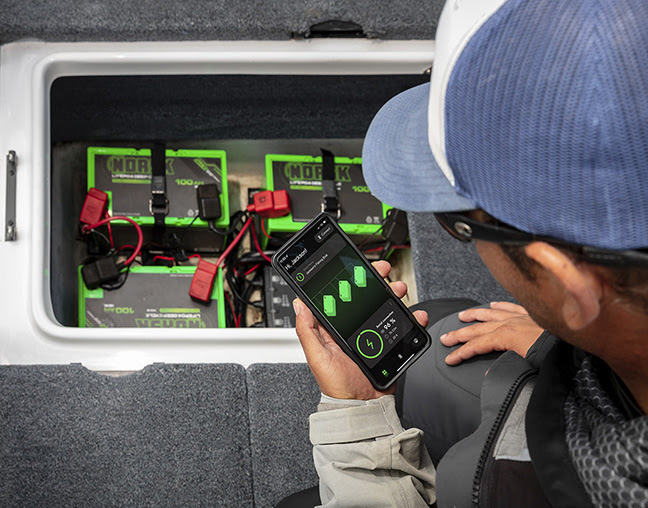
| Why Lithium Batteries Make SenseWhile trolling motors, fishing electronics, and outboards get all the press, it’s the quality and reliability of your boat’s batteries that make all the fun stuff happen on the water. Think that’s an exaggeration? How much fun is that shiny 250 horsepower outboard when you turn the key and, instead of being greeted by the growl of an outboard roaring to life, you are left with nothing but the disappointing “click” of a starter starved of the amps it needs to bring those 250 ponies to life? In that moment, the boat ramp or tournament weigh in has never felt further away, while your boat has never felt smaller due to those uncomfortable stares coming from your fishing partner.And what role do quality, reliable lithium batteries play in making all the advancements in sonar technology possible? As all too many anglers have experienced after they’ve made the investment to upgrade their boat’s electronics, if you overlook how they’ll be powered on the water, you’re in for a very disappointing first trip putting all that fancy sonar to use. Fact is: You cannot power three big graphs at full brightness all day with a lead acid battery and avoid the dreaded low-voltage alarms popping up time and time again on your sonar screens. Sorry, ain’t gonna work. Collectively, those big screens simply draw too many amps for even the largest lead acid battery to handle and, if you add in MEGA Live, LiveScope, or Active Target, you can tell your wife when you leave in the morning that you’ll be home for lunch and actually keep that promise, albeit reluctantly.NORSK Lithium CMO, James Holst, remarks: “With our LifePO4 chemistry, we guarantee 80% percent capacity will remain after 4000 discharge cycles. You’d have to be a retired person who fishes every hour of every day for over a decade to get to those numbers. To get that out of lead acid batteries you’d be looking at replacing your batteries 8 to 10 times.”“Who wants to spend that much money on a boat and fish-finders so you can fish for half a day? Personally, I want to control my experience completely on the water. Cutting yourself short by choosing subpar batteries as foundational power is ridiculous. After a lot of bad experiences on the water, a lot of anglers are waking up to that and moving to lithium.”Holst continues: “I’ve used the same set of NORSK lithium batteries in my past four boats: two Skeeters, a Lowe jet boat, and now a Warrior 238, and they still pull like a tractor. I have not seen any reduction in capacity over this time. I fish long and hard days, deeply discharge my batteries, and there’s no chance I’d be able to say the same thing about a set of lead acid, AGM, or gel-cell batteries. I would have plowed through numerous sets in that span of time and had multiple days on the water ruined due to batteries that were no longer up to the task at hand.”An additional and often overlooked advantage of lithium is the voltage discharge curve of a lithium battery is very flat, ensuring that your first 10% of discharge will be almost the same as the last 10% of the discharge cycle.Why does this matter? A flat voltage discharge curve means the trolling motor head and blades will turn at the same speed at the end of the day that they did at the start of it, giving you the control and speed you expect from your expensive bow-mount trolling motor.NORSK Lithium founder and Engineering Director, Derek A., interjects: “With lead acid batteries, as soon as the second and third year of operation you aren’t getting full utility out of your boat because your batteries are only running half as long as they did the year before.”Derek continues: “It’s amazing how disabling but predictable lead acid batteries are. If you’re fishing like I do and constantly discharging them below 50% and recharging them back up, you probably need to change them annually. That adds up year after year. That’s precisely why I founded NORSK Lithium. As an angler, I knew there had to be something better. So I—along with a very knowledgeable team of other engineers and anglers—designed it.” |
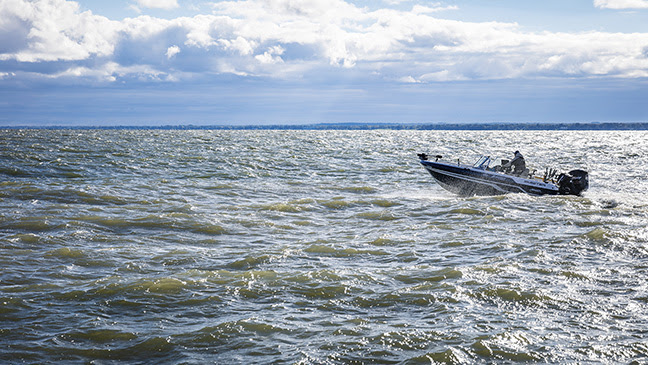
| Gain Boat SpeedGiven the decrease in weight from lead acid or AGM, anglers/boaters who have switched over to lithium batteries report an average boat speed increase in the neighborhood of 2 to 5 mph. Do we recommend you buy lithium batteries for a couple more MPH? We conceded that likely shouldn’t be your primary motivation. But going fast is fun and, given all the other foundational benefits lithium batteries provide, who’s going to turn up their nose at being able to walk away from the competition at the next shotgun start?Lithium: Lighter and More Compact Lithium is also very light in comparison to lead acid, AGM, and gel cell batteries—what typically amounts to about 45% less weight than the similar size group size lead acid or AGM.For example, a NORSK Lithium 100AH battery weighs approximately 25 pounds. A comparable battery would be a 31 series lead acid deep cycle that weighs approximately 60 pounds.Lithium batteries often have a smaller footprint, too, which makes installation in a lot of boats easier. With NORSK’s new advances in starting/deep cycle lithium battery combinations, finding a spot in your boat for a fifth battery (frequently referred to as a “house” battery), is no longer required.NORSK Lithium has done significant testing to design the ultimate starting/deep cycle lithium battery.Company founder and Director of Engineering, Derek A., remarks: “We’ve figured out which cells can deliver that big, quick burst of energy in the shortest period of time to turn over very large outboard engines. We’ve also made sure the internal wiring as well as all the conductive cells can handle that current. Lithium batteries sold as starting batteries up to this point have had significant issues. If you don’t have the proper internal wiring to carry high current, that power surge can melt the terminals right off the top of the battery. It all comes down to managing the resistance, something we’ve been able to do with our new dual-purpose NORSK Lithium starting/deep cycle battery design.”Holst interjects: “We took Mercury’s requirements for a starting battery—the specs that spelled out their stringent guidelines and warranty expectations—and used that as a starting point. We have the absolute best starting battery on the market in our 180Ah Starting + House battery and we added a lot of extra capacity to it so an angler struggling to find space for a “house” battery to power their sonar units doesn’t have to tear their boat apart and give up valuable storage space looking for room for yet another battery. Our 180Ah Starting + House battery performs both roles beautifully and frees up anglers to stop worrying about battery capacity and runtime and just focus on fishing!”Holst continued: “With NORSK Lithium, anglers can uncomplicate things a bit and, in the case of a traditional 36V setup, pare down to three 12V batteries rigged in series for the 36V trolling motor set-up and one dedicated “Starting + House” battery for both your outboard engine and electronics. Our new design has plenty of capacity to run everything all day long. It meets and exceeds Mercury’s warranty requirements for starting batteries, offers up to 1200 cold cranking amps (CCA) and is going to last a long time—10 plus years, easy—or a minimum of 4000-plus discharge cycles. It’s a great solution. Solves two problems with one battery.” |



